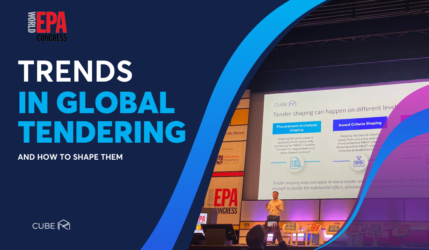Albert Einstein once said that “In the middle of every difficulty, lies an opportunity”. If you are a business on a mission to start your tendering activities, this quote may be hitting a sensitive nerve! The tendering market is a very attractive and growing one, with a lot of untapped potential, but at the same time we are talking about a complex, rapidly changing, and highly demanding business.
Throughout the years of working with different organizations, we have come to the realization that there are a lot of different myths, rumors, and misconceptions around tendering & bidding, that tend to discourage those who want to explore the opportunities of tendering for their business development.
Let’s start deconstructing these myths one by one and reveal the reality behind a challenging, but exciting and very promising process, that is tendering
Myth #1: Our tendering business is so solid that I’m sure we have full visibility of the relevant tenders every year.
The huge number of available tender sources around the world and their diversity in terms of data coverage, structure, and technologies makes it almost impossible, even for the best run companies to fully capture all relevant tender opportunities. There is always room for improvement that starts from a few percentage points to strong double digit growth improvement in terms of revenue and tender visibility. For instance, advanced Natural Language Processing (NLP) technologies and automated online tender sources connectivity can be used by all companies regardless of size and nature of business to improve their tender visibility.
Furthermore, having full visibility of upcoming tenders locally, is of course important and a great starting point, but having an automated, regionally or globally, consolidated view through the right software tool, can further help your organization to unlock even bigger potential.
Myth #2: Planning ahead for future tenders is almost impossible, as we don’t know what lies ahead and constantly running behind schedule.
Indeed, planning ahead for anticipated, not yet published tenders, is an important but also difficult task for most companies involved in tendering. However, tenders tend to come in cycles based on continuous customer needs for replenishment or replacement and/or after the expiration of an existing contract of an awarded tender. This fact makes the tendering market highly predictable in most cases and can help companies plan ahead effectively for future tender opportunities, which can improve tender preparation and decision making significantly and become a true competitive advantage.
Myth #3: Because we have limited time to prepare and limited resources, we have to struggle to effectively pursue tenders on time.
Indeed, the available time to submit a tender response in most markets varies from 1-2 months, which makes it very challenging, especially for bigger tenders or smaller teams. Furthermore, tendering has an inherent complexity due to the big differences per market in terms of available tender sources, type of tenders, decision making criteria, pricing, language used, documentation needs, and many more. All these can be very demanding in terms of people and resources, but use of innovative technologies and software tools can ease the pain considerably. Using Natural Language Processing (NLP) technology, for instance, can help a company automatically discover new tender opportunities from multiple countries and sources and import them within the company’s CRM, without the burden of everyday manual search and data entry. This, combined with other capabilities that help automate data retrieval, tender response preparation, tasks and document management, or other important areas can help considerably the pursuit and preparation of tenders on time and even by much smaller teams.
Myth #4: It’s always the cheapest bid that wins.
If it is a price only tender, then, by definition, this is usually true. But even in this case, you might have tenders with multiple winners where you can still get a part of the requested quantity at a higher price and profitability! Furthermore, there are many tenders combining price with quality criteria, where it’s not the lowest bidder who wins but the best balance of price and quality. In Europe alone, roughly half of the tenders have quality criteria as well, albeit with big differences per market and weightings. Depending on the market archetype, it is critical to understand the award criteria and hidden customer needs and objectives and to develop a relevant and convincing value proposition beyond price.
Myth #5: There is no way to predict the pricing of our competitors and identify the best bid for the tender.
It’s certainly challenging to guess what your competitors will do for a tender. Will they participate or not, which products will they use, will they bid high or low. These are just some example questions that one should consider before deciding the pricing strategy for a specific tender. And even when we have some answers, these are not concrete but usually rough estimates and scenarios with a lot of uncertainty. This makes it difficult to take advantage of the available and, usually, limited information since the different scenarios to consider are practically infinite and almost impossible to process.
But then again, Machine Learning statistical models are used to do exactly that, i.e. process the information statistically to reduce uncertainty and offer predictive pricing guidance. Granted, tenders have some additional challenges that may render standard predictive models useless, such as the limited historical data and the quality or price evaluation criteria that increase complexity. However, given the right sophistication highly specialized predictive models for tenders can automatically generate and compare numerous different scenarios and simulations and produce valuable insights like the probability to win a tender and finding that sweet spot between this probability and profitability. And latest machine-learning technology, applied in a tender-specific way, can definitely help.
You can always check our newest AI-based Pricing Guidance tool, designed to guide you through the complicated process of finding the optimal tender price.
Myth#6: The tender is like a boomerang. It always returns to the previous winner.
Having lost a tender certainly puts your competitors at a better position to win the next one as well. But this by no means is written in stone and can definitely change. For instance, you can anticipate the contract expiration for a lost tender and plan ahead accordingly, even before months or years, if you monitor outcomes and awards regularly. Furthermore, if you monitor your sales performance and process efficiency and learn from the mistakes of the past you can be proactive and take corrective action in order to be better positioned for the next tender. By systematically tracking outcomes, building intelligence and continuous improvement you can start gaining back your previously lost market share and beyond.
Myth #7: Because tendering is so country specific and runs through local affiliates or distributors, it is impossible to control or monitor centrally.
The first part is certainly true, since tenders are mostly released per country from local online tender sources and in most cases using the local language, and different decision-making criteria per market and customer. On top of that, using distributors, which is a common practice in many markets, further blurs your visibility as you rely entirely or partly on them to provide valuable information for your tender market. All these facts make the tendering business highly localized and extremely complex, and some people tend to believe that it is therefore impossible to guide or monitor centrally.
Well, it’s certainly challenging, but with the right technology you can definitely achieve this. For instance, it is feasible to connect electronically and consolidate information from multiple tender sources around the world and consolidate the information into your CRM system (e.g., Salesforce.com). And the technology exists for multiuser interaction and collaboration through the same or cross countries to manage tenders, tasks, documents, and have an overview over numbers, performance, and efficiency. And all these can be as centrally or locally controlled as we would like since users’ access rights, approval policies, workflows, and everything can be either uniform or differentiated per country or division resulting in a truly central system of collaboration which also has the flexibility to adapt to local demands and circumstances equally well.
As you can see tendering complexity is always in the eye of the beholder: different people have different opinions, according to their own experience. The reality is, that whether you are a smaller or bigger organization, an experienced tender manager or just starting to build your tendering department and/or team, a previous winner or an aspiring one, there is always room for improvement and a lot to gain in this competitive game.
Tendering is a team sport; you need a dedicated team, motivation, resources, and technology, in the form of a specialized tool by your side to build up and improve the whole process.
We really hope that after reading this, we have given you more reasons to disregard the false beliefs and start working towards your tendering business goals. If you recognize or are concerned by any of the above, we will be happy to further discuss how you can elevate your tendering strategy and take it to the next level!
In the meantime, you can always take our FREE Tendering Maturity Assessment to find out the truth about your current tendering performance. You will also get actionable advice and tips on how to improve the areas with the greatest potential for growth.










 21/03/2024
21/03/2024 

